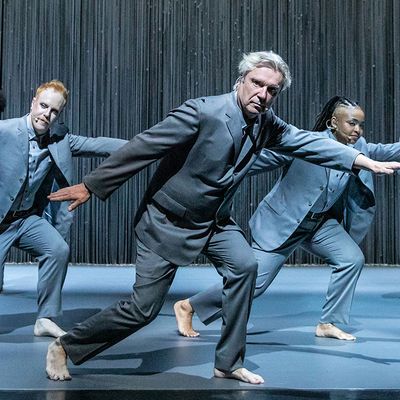
The world isn’t the same as it ever was in David Byrne’s American Utopia, his gorgeous Broadway show that electrifies your senses straight into a 90-minute monochromatic stage paradise. (Bare feet and suits included.) There’s Talking Heads standards. Deeper Byrne cuts. Unexpected comic relief, compliments of Hugo Ball’s musings. But perhaps the main joy is transmitted through Annie-B Parson’s choreography — a virtuosic simplicity that keeps everyone, musician or otherwise, in a joyous nonstop movement from start to finish. (Movement that, we guarantee, you’ll be trying to replicate as soon as the curtain falls.) We spoke to Parson about her American Utopia experience and what it’s been like to work alongside Byrne. Unsurprisingly, it was a once-in-a-lifetime creative opportunity.
What was your first meeting with David like?
It was a really long time ago, I think in the ’90s. We had a mutual friend who brought him to see my work in a church basement in the East Village. I later properly met him through this friend, and we didn’t see each other again for ten years. I was such a huge fan. You know how it is! But when he did his Brian Eno tour a few years ago, he asked me and a few other choreographers to do work for him. I choreographed two songs for that show, and then he asked me to make a few more.
How did that lead you to American Utopia?
I was in London for work and he sent me some demos from the album in anticipation of the tour. The first song I heard was “Dance Like This.” I thought it was so genius and witty. I love David’s wit. I thought the flatness of the statement coupled with the overuse of drum machines was hilarious. I had this idea that maybe we could stop in the middle of the song. That’s an example of a song where the idea came right away of what I wanted to do. So, I was working on my own. He would send me songs and I would work wherever I was — hotels, my bedroom, wherever I was. It was a really precious time. Hearing the material fresh and experiencing it for the first time is really important. If you hear it so much, sometimes you can shut down to what you’re hearing. That first time hearing something is where I get most of my ideas.
How specific was David about the choreography he wanted?
It was an amazing creation for this piece. Often when I work with directors, or when I’m directing myself, what you think at the beginning often changes. That’s fair and normal. But with this show, the ideas David first presented me with have not changed. They wear gray suits, everyone being untethered, and we’re in a white box with a white floor. But it was going to be warm. We both felt that everyone had to have bare feet, too, because of the dancing. Shoes just didn’t make sense. That’s what the show is. It’s got a minimalist aesthetic but it’s somehow very warm. I’ve worked with him for so long that I can literally get in his body.
I like watching how David constructs things. Not just watching, but experiencing it, because it affects everything that I’m doing. I feel like I’m working with this extraordinary artist who’s figuring things out in real time. His process is extremely rewarding to be a part of. He looks at everything with very precise observations, and Broadway was the same way. He’s really one of the great citizen artists of our time. It’s for real with him. It’s cool to be with someone who cares that much about the world.
What’s your process for thinking up concepts for each song?
What is the shape of this song? What’s going to happen? Is it conceptual? David would throw me ideas, too. He was in India and he saw this traditional Indian theater and sent me photos. Or he was biking in the Rockaways and saw something interesting. Things like that. I know what he’s thinking. He doesn’t go, Let’s try that for this song. He’ll go, This stuff interests me, let’s try to fit it in. He’s an omnivore culturally. He’s not direct.
What other things did he send you?
My favorite thing was the very first text he ever sent me for work, which was actually for the Eno show. He sent me this cult Japanese movie from the ’70s. It was … so fucking out-there. [Laughs.] I loved it so much. It was three Japanese dudes who break into dance material at random times. It was very isolated and strange dancing, and it had no organic relationship to anything that was happening. One of the moves was that they stuck their arms out, hit their shoulders twice, and then hit their shoulder twice again. Everything I made for David since has included some version of that. He just conveyed, I like this and I’m thinking about this. It’s interesting to me. It may feel anachronistic or paradoxical to what we’re working on but maybe it can be fit in. I have so many references in the show to stuff you’d never know that’s buried in there, like Oskar Schlemmer. You don’t need to know that those references are there, but I’m interested in them. I’m kind of a magpie.
Did he ever set limitations on how far he wanted to go with the physicality of the choreography?
Not really. He’s very nonverbal about what he wants. I come in with a lot of material and then we do it and I teach it. Sometimes he’ll not be loving something and I can sense that.
What’s his tell that he doesn’t like something?
He doesn’t say it. He just doesn’t end up doing it. It falls away. I can’t describe it, it’s so nonverbal. It’s a vibe. It’s a lack of excitement. He’s such a good choreographer for himself. Even when I first met him and he asked me to do the show, I was like, Huh, you’re my favorite choreographer, what are you doing!? Being able to make movement for yourself and being a choreographer are quite different, and he’s not interested in making movement for other people. He is a dancer. Some of the stuff he does in the show he totally made up for himself.
What are some of the best moves he made for himself, in your opinion?
He does this thing where he slaps his hands while crossing the stage in “Slippery People” that’s so amusing to watch. He goes down on the ground at one point in “Once in a Lifetime” and I asked him what he was doing, and he was like, “Um, I’m going down to the water in the ground.” He’s imagining things and feeling the music. “Loose” wouldn’t be the word because neither of us are loose at all. He’s incredible as an artist in the way he thinks and acts on things. I’ve always felt that I have a huge amount of freedom.
Were there certain songs that came more naturally to you while choreographing the show, and, on the contrary, which proved to be the most difficult?
The hardest song was “The Great Curve,” which isn’t even in the show anymore. [Laughs.] It wasn’t because we didn’t love it, but the show was too long for the Broadway format. “Everybody’s Coming to My House” came a little slow. The quick ones were “Don’t Worry About the Government” and “Dog’s Mind,” which was also cut. I had to choreograph the shadows in “Blind” and that needed a lot of time to master. It’s only one light!
Were there other songs tested that ultimately didn’t make the show?
We talked about doing “Nothing But Flowers.” We also talked about doing “Doing the Right Thing,” but David decided to take it out because he felt it was too ironic. He was working with an emotional palette and it didn’t fit in. We also talked about closing the show with “Angels.” It’s a large-scale, super-epic song and it sends people out flying. It’s not darkly red like “Great Curve,” it’s more like a sparkly blue. On the other hand, though, David added “I Know Sometimes a Man Is Wrong” and “Don’t Worry About the Government” to slow down the beginning of the show, because he felt the Broadway audience should listen and not get on their feet right away. We didn’t have an encore for a really long time, too, and we thought, On Broadway, do we even get an encore? They told us yes, so we added “Road to Nowhere,” especially because the chains come up around the stage and you can move around really easily.
Has working with David left you more creatively fulfilled than other projects in the past?
In a sense, yes. He believes the body is a deeper archive than any library or website you can find. If I’m feeding him new material, he’s always bringing so much more to it because of his dance history. The show becomes a sing-along a little bit with certain songs because people know them, and it’s beautiful, and it’s the same with movement. People can know movement the way they know lyrics. They don’t know that they know it, even if it’s not part of the mainstream. I had suggested to David that he quote some of the movements he had done in the past, but he didn’t want to because he never wants to look back. So I was like, “Okay, but just one movement.” I wanted the audience to realize that dance matters and it’s a part of their memory. So he did that arm-choppy thing in “This Must Be the Place.” He conceded to the past, just once.


